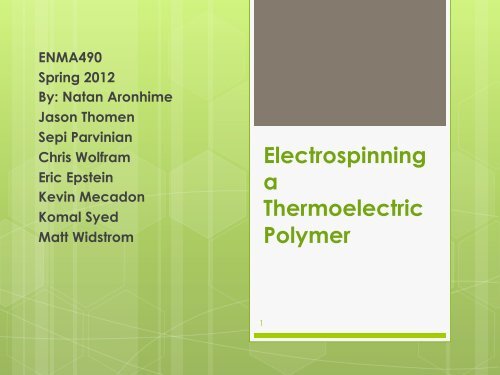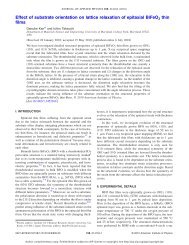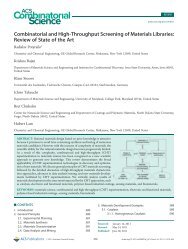Electrospinning a Thermoelectric Polymer - Materials Science and ...
Electrospinning a Thermoelectric Polymer - Materials Science and ...
Electrospinning a Thermoelectric Polymer - Materials Science and ...
Create successful ePaper yourself
Turn your PDF publications into a flip-book with our unique Google optimized e-Paper software.
ENMA490<br />
Spring 2012<br />
By: Natan Aronhime<br />
Jason Thomen<br />
Sepi Parvinian<br />
Chris Wolfram<br />
Eric Epstein<br />
Kevin Mecadon<br />
Komal Syed<br />
Matt Widstrom<br />
<strong>Electrospinning</strong><br />
a<br />
<strong>Thermoelectric</strong><br />
<strong>Polymer</strong><br />
1
2<br />
Motivation<br />
People using too<br />
much energy<br />
Need renewable<br />
sources<br />
http://www.heatingoil.com/category/blog/opec-blog/<br />
A tremendous<br />
amount of energy<br />
is wasted as heat<br />
http://www.savewaveenergy.com/store/alternative_energy
3<br />
<strong>Thermoelectric</strong>s<br />
Bismuth Telluride most common<br />
thermoelectric<br />
Expensive<br />
<strong>Polymer</strong>s<br />
Good electrical conductivity<br />
Naturally poor thermal conductivity
4<br />
Design Goals<br />
Design a thermoelectric device using electrospun<br />
conductive polymer fibers<br />
Predict thermoelectric properties of our device<br />
Target: Power factor on order of PEDOT:PSS thin film<br />
Power Factor = 4.8 x 10 -6 W/mK 2<br />
Efficiency = .006%<br />
Predict size of electrospun fibers based on easily<br />
measurable processing parameters to within 9%<br />
error
5<br />
Intellectual Merit<br />
Extend dimensional analysis (Helgeson et.<br />
al. 2008) to electrospinning with carrier<br />
polymer <strong>and</strong> asses accuracy/applicability<br />
Compare conductivity <strong>and</strong><br />
thermoelectric parameters of fibers to<br />
bulk
6<br />
Broader Impacts <strong>and</strong> Ethics<br />
Wasted heat is almost everywhere<br />
Efficient conversion of thermal gradient to electricity<br />
ΔTà ΔV<br />
Optimization of <strong>Thermoelectric</strong> properties/minimizing<br />
cost<br />
Increase in fiber alignment by stretching during<br />
electrospinning<br />
Many thermoelectric devices are either not cost<br />
effective or use complicated processing techniques<br />
Some of our solvents can be harmful if released in<br />
large quantities<br />
<strong>Electrospinning</strong> uses very high voltages
7<br />
Basic Design<br />
High V<br />
Power<br />
Source<br />
Syringe with electrospinning<br />
solution<br />
Glass slide with two<br />
grounded Cu electrodes
8<br />
PEDOT:PSS<br />
http://clevios.com/media/webmedia_local/media/datenblaetter/81076210_Clevios_PH_1000_20101222.pdf<br />
General Properties:<br />
Conductive polymer<br />
Soluble in water<br />
<strong>Thermoelectric</strong> Properties:<br />
Electrical Conductivity (thin film) = 850 S/cm<br />
Bi 2 Te 3 =1100 S/cm (M. Takelishi et al., Japan Symposium on Thermophysical<br />
properties, 2006.)<br />
Seebeck coefficient (thin film) = ~10 μV/K<br />
Bi 2 Te 3 =287 μV/K (Proceedings of SPIE. 5836, 711)
9<br />
Material Selection<br />
Electrospin PEDOT:PSS<br />
Good electrical properties<br />
Research reveals pure PEDOT:PSS very difficult to<br />
electrospin<br />
Carrier polymer required for electrospinning:<br />
Polyacrylonitrile (PAN)<br />
Dopant: Sorbitol<br />
Copper electrodes<br />
Lower workfunction than PEDOT-ohmic contact
10<br />
<strong>Materials</strong> <strong>Science</strong> Aspects<br />
Material Properties<br />
Processing<br />
<strong>Electrospinning</strong> voltage<br />
<strong>Electrospinning</strong> flow rate<br />
Shear thinning<br />
Electrical conductivity<br />
Thermal conductivity<br />
Seebeck coefficient<br />
Viscosity<br />
Surface tension<br />
Dielectric constant<br />
<strong>Polymer</strong> entanglement<br />
Solid State Physics<br />
Density of states<br />
Fermi level shift<br />
Characterization<br />
SEM<br />
Tensiometer<br />
Viscometer<br />
LCR meter<br />
Nanovoltmeter<br />
<strong>Materials</strong><br />
Chemistry<br />
Weight percent calculations<br />
Solution miscibility<br />
Solubility<br />
Carrier polymers
11<br />
Technical Approach: VRH<br />
We will test Variable Range Hopping<br />
Electrical conductivity:<br />
σ=σ↓0 exp[−(T↓0 /T )↑γ ]<br />
PEDOT:PSS <strong>and</strong> PAN can be arranged<br />
either in parallel or in series within the fiber<br />
σ↓Parallel =σ↓PAN φ↓PAN +σ↓PEDOT <br />
φ↓PEDOT <br />
σ↓Series =1/φ↓PAN /σ↓PAN +φ↓PEDOT /<br />
σ↓PEDOT<br />
Lichtenecker equation is an in-between case<br />
log(σ↓T )=φ↓PEDOT log(σ↓PEDOT )+φ↓PAN<br />
log(σ↓PAN )
12<br />
Technical Approach: VRH<br />
Seebeck coefficient<br />
S=k↓B↑2 /2e (T↓0 T)↑1/2 (dlnN(E)/<br />
σa>>σb<br />
dE )↓E=Ef<br />
ST = Sa<br />
ST = Sa * σa + Sb * σb<br />
σa + σb<br />
Annika Lenz, Hans Kariis, Anna Pohl, Petter Persson, Lars Ojamae. (2011). The<br />
Electronic Structure <strong>and</strong> Reflectivity of PEDOT:PSS from Density Functional<br />
Theory. Chemical Physics, 384, 1-3<br />
Park, Sungeun, Sung Ju Tark, <strong>and</strong> Donghwan Kim. "Effect of Sorbitol Doping in<br />
PEDOT:PSS on the Electrical Performance of Organic Photovoltaic Devices."<br />
Current Applied Physics 11.6 (2011): 1299-301
13<br />
Technical Approach: VRH<br />
Using image J DOS information was extracted around the Fermi<br />
energy. Optimal Seebeck Coefficient: 6.20E-04 V/K corresponds<br />
to a Fermi energy shift of 0.075 eV <strong>and</strong> 1.8% sorbitol.
<strong>Electrospinning</strong>: Solutions<br />
Prepared<br />
Design (Ideal)<br />
Solution<br />
-PEDOT:PSS <strong>and</strong><br />
sorbitol in<br />
EG:NMP<br />
-PAN in DMF<br />
-Individual<br />
solutions mixed<br />
Diluted<br />
Solution<br />
Clevios<br />
- Successfully<br />
electrospun<br />
- Ratio PEDOT:PSS - 7.1 wt% Clevios<br />
to PAN reduced (water + PEDOT)<br />
from 5% to 3.34% -<br />
- Attempted to<br />
0.08% wt%<br />
PEDOT<br />
electrospin: - 8 wt% PAN<br />
Failed<br />
- DMF solvent
15<br />
Background: <strong>Electrospinning</strong><br />
Underlying theory based on<br />
“electrohydrodynamics” (Taylor & Melcher, 1966)<br />
In 2001, Hohman et al. predict 3 modes that<br />
apply to electrospinning/electrospraying:<br />
Rayleigh mode<br />
Dominated by surface tension effects<br />
Applies when low/no electric field<br />
Axisymmetrical conducting mode<br />
Whipping conducting mode<br />
Dominate due to<br />
surface charge effects<br />
at high field strengths
16<br />
Whipping vs. Axisymmetrical Modes<br />
Decreasing Applied Electric Field<br />
POLYMER ENGINEERING AND SCIENCE, 2005, 705<br />
Take-home message: Balance of electromechanical<br />
stresses with intrinsic stresses within fluid (viscosity/capillary<br />
stresses) lead to formation of stable jet
Electrospin Modeling: Dimensional<br />
Analysis (Helgeson et. al. 2008)<br />
Π= (ε−ε↓0 )E↑2 R↓j↑3 /π<br />
η↓e Q<br />
Oh=η↓0 /(ργR↓j )↑0.5<br />
captures the jet<br />
dynamics during the<br />
streching regime<br />
captures free resistance to jet<br />
breaking up into droplets <strong>and</strong><br />
surface flow disturbances which<br />
lead to capillary breakup<br />
Simplified expression<br />
(Helgeson et. al. 2007)
Electrospin Modeling: Experimental<br />
Observations<br />
Oh=HΠ1↑−m<br />
Rj ∝ solution parameters<br />
18<br />
PEO-water<br />
PEO-water-ethanol<br />
poly(ethylene terephthalateco-ethylene<br />
isophthalate)-chloroform-<br />
Dimethylformamide<br />
poly(methyl<br />
methacrylate)-dimethylformamide<br />
(Figure from Helgeson et. al. 2007)
Electrospin Modeling: Experimental<br />
Observations<br />
Oh=HΠ↑−m<br />
Rj ∝ solution parameters<br />
19<br />
(Figure from<br />
Helgeson et.<br />
al. 2008)
Electrospin Modeling: Determination of R j <strong>and</strong><br />
R f relation<br />
Usually, this approximation made:<br />
R↓f =R↓j <br />
w↓p↑0.5<br />
Derivation from volume conservation:<br />
20<br />
w↓p =πR↓f↑2 l↓f /πR↓j↑2 l↓j →w↓p =R↓f↑2 l↓f /R↓j↑2 l↓j<br />
Wang et. al. 2007 determined experimentally:<br />
R↓f =R↓j w↓p↑0.9653 =R↓j w↓p↑0.5 <br />
w↓p↑0.4653 ; √l↓j /l↓f =w↓p↑0.4653<br />
Extra term inverse extension ratio, dominated by solvent<br />
evaporation
Electrospin Modeling: Determination of R j <strong>and</strong><br />
R f relation<br />
21<br />
(Data from El-Aufy 2004)<br />
Limited data,<br />
differing<br />
solvent<br />
evaporation<br />
ratesà No<br />
smooth fit<br />
possible
Electrospin Modeling: Determination of R j <strong>and</strong><br />
R f relation<br />
22<br />
Estimate solvent<br />
evaporationà<br />
qualitatively correct<br />
fit at low w p (region<br />
of interest for<br />
design)à use fit in<br />
calculationsà<br />
assume<br />
R↓f =R↓j w↓p↑0.9653<br />
(Wang et. al. 2007)<br />
b/c PAN in DMF is<br />
dominating the fit<br />
curve
Electrospin Modeling: Dimensional Analysis<br />
Helgeson 2007 Plot<br />
23
Electrospin Modeling: Dimensional Analysis<br />
Helgeson 2008 Plot<br />
24
Effect of viscosity:<br />
Too low viscosity à jet breaks up to polymer droplets<br />
à electrospraying<br />
Low viscosity causes formation of beaded fiber<br />
Very high viscosity à unable to pump the solution<br />
There is a viscosity range which electrospining is<br />
effective<br />
As viscosity increases so does the average fiber<br />
diameter<br />
25
Viscosity of Diluted Solution:<br />
Viscosity was measured by cone<br />
<strong>and</strong> plate viscometer<br />
Data was inaccurate due to<br />
excessive noise<br />
Qualitative analysis:<br />
<strong>Electrospinning</strong> failed due to<br />
very low viscosity<br />
Diluted “solution” turned out to<br />
be suspension of polymer, not<br />
solution<br />
Fluid broke up into droplets rather<br />
than forming stable Taylor cone
Viscosity Tests on Clevios Solution:<br />
Viscosity was measured by cone <strong>and</strong> plane viscometer<br />
σ= kɵᵒn<br />
n=0.43 (power law index)<br />
Shear-Thinning Fluid :<br />
27<br />
Still within the window of electrospinning
28<br />
<strong>Electrospinning</strong> Result: Fibers<br />
from Clevios Solution<br />
Fiber diameter range: 100-250nm
29<br />
TE Modeling Results:<br />
σ ll (S/<br />
cm)<br />
σ Li (S/<br />
cm)<br />
PF ll (W/<br />
mK 2 )<br />
PF Li (W/<br />
mK 2 )<br />
η ll (%) η Li (%)<br />
Ideal<br />
Solution<br />
Diluted<br />
Solution<br />
.125 1.48 E-11 4.79 E-6 5.67 E-16 .006 7.33 E-13<br />
.103 1.21 E-11 3.98 E-6 4.67 E-16 .005 6.03 E-13<br />
Clevios .024 5.81 E-12 9.21 E -7 2.23 E-16 .001 2.88 E-13<br />
Goal:<br />
PF = 4.8 x 10 -6 W/mK 2<br />
η = .006 %
TE Measurements on Prototype<br />
Seebeck Coefficient: S=−∆V/∆T<br />
Measure using voltmeter <strong>and</strong> thermocouple<br />
while heating<br />
Measured a value of 6.36 μV/K<br />
Attempted to measure electrical conductivity<br />
using four point probe: R= l/σA<br />
Unable to obtain measurements using 4 pt.<br />
probe
31<br />
Conclusions: <strong>Thermoelectric</strong><br />
Goals <strong>and</strong> Insight from Results<br />
Goal: to fabricate nanofiber TE device<br />
that rivaled that of PEDOT:PSS thin films in<br />
terms of Power Factor <strong>and</strong> efficiency<br />
Insight from Results: If percolation is<br />
reached, can obtain similar efficiency to<br />
a doped PEDOT:PSS thin film<br />
(Less conductive polymer required)
32<br />
Conclusion: <strong>Electrospinning</strong><br />
Goals <strong>and</strong> Results<br />
Goal: Predict diameter of electrospun fibers based on<br />
easily measurable processing parameters<br />
Results: Helgeson model does not fully agree to<br />
experimental observations of complex systems<br />
Insight from Results: Dimensional analysis still useful as<br />
engineering design tool<br />
Future work: Design electrospinning solution using PEO<br />
as carrier polymer<br />
Cleaner environmental impact: use water as solvent<br />
Obtain accurate trends of dielectric constants, viscosities,<br />
<strong>and</strong> surface tension in polymer solutions to make more<br />
robust model
Facilities<br />
Dr. Hu – electrospinning device & SEM<br />
Dr. Rabin – electrical conductivity <strong>and</strong> Seebeck<br />
coefficient<br />
Physics Machine Shop (Setup prepared) <strong>and</strong> LCR<br />
meter in Undergraduate Teaching Lab(KIM)-<br />
Dielectric Constant Measurements<br />
<br />
Dr. Calabrese <strong>and</strong> Dr. Raghvan for rheology<br />
measurements<br />
Dr. Phaneuf’s lab for solution preparation
35<br />
Acknowledgements<br />
First <strong>and</strong> foremost, we would like to thank Dr.<br />
Phaneuf for helping <strong>and</strong> guiding us throughout the<br />
semester with this project. In addition, we would<br />
like to thank all the faculty members who have<br />
met with us, helped us, <strong>and</strong> let us borrow their labs<br />
<strong>and</strong> grad students. Without these resources, we<br />
would not have been able to accomplish what<br />
we did. Lastly, we would like to extend our<br />
sincerest appreciation to the entire faculty of the<br />
<strong>Materials</strong> <strong>Science</strong> department. It is the education<br />
<strong>and</strong> guidance that you provided over the years<br />
that enabled us to come this far.
References<br />
[1] Nidhi Dubey <strong>and</strong> Mario Leclerc. (2011). Conducting <strong>Polymer</strong>s: Efficient <strong>Thermoelectric</strong> <strong>Materials</strong>. Journal of <strong>Polymer</strong><br />
<strong>Science</strong> Part B: <strong>Polymer</strong> Physics, 49 (7). http://onlinelibrary.wiley.com/doi/10.1002/polb.22206/pdf<br />
[2] Kaiser, A. B. "<strong>Thermoelectric</strong> Power <strong>and</strong> Conductivity of Heterogeneous Conducting <strong>Polymer</strong>s." Physical Review B 40.5<br />
(1989): 2806-813.<br />
[3] David K. Taggart, et al. Enhanced <strong>Thermoelectric</strong> Metrics in Ultra-long Electrodeposited PEDOT Nanowires. Nanoletters,<br />
2010.<br />
[4] Farshad Faghani. Thermal Conductivity Measurement of PEDOT:PSS by 3-Omega Technique. Thesis, Linkoping University,<br />
2010.<br />
[5] Afaf Khamis El-Aufy. (2004). Nanofibers <strong>and</strong> Nanocomposites Poly(3,4-ethylene dioxythiophene)/Poly(styrenesulfonate)<br />
by <strong>Electrospinning</strong>. (Doctoral dissertation).<br />
[6] Dale S. Pearson et al. Effect of molecular Weight <strong>and</strong> Orientation on the Conductivity of Conjugated <strong>Polymer</strong>s.<br />
Macromolecules Vol. 26, 2003.<br />
[7] Environmental Fate <strong>and</strong> Effects of Ethylene Glycol used at Airports. American Chemistry Council. February 2000.<br />
http://www.huntsman.com/performance_products/media/fate_<strong>and</strong>_effects.pdf<br />
[8] G. Long, M. E. Meek, <strong>and</strong> M. Lewis. N,N-dimethylformamide. World Health Organization, United Nations Environment<br />
Programme, <strong>and</strong> the International Labor Organization. 2001. http://www.who.int/ipcs/publications/cicad/en/cicad31.pdf<br />
[9] Environmental Profile N-Methylpyrrolidone. EPA, 1998. http://nepis.epa.gov<br />
[10] D. A. Saville. ELECTROHYDRODYNAMICS: The Taylor-Melcher Leaky Dielectric Model. Annu. Rev. Fluid Mech. 1997. 29:27–<br />
64.<br />
[11] Moses M. Hohman, Michael Shin, Gregory Rutledge, <strong>and</strong> Michael P. Brenner. <strong>Electrospinning</strong> <strong>and</strong> electrically forced jets.<br />
II. Applications. Phys. Fluids, Vol. 13, No. 8, August 2001.<br />
[12] Sergey V. Fridrikh, Jian H. Yu, Michael P. Brenner, <strong>and</strong> Gregory C. Rutledge. Controlling the Fiber Diameter during<br />
<strong>Electrospinning</strong>. Phys. Rev. Lett., 2003, 90, 14, 144502-1-144502-4.<br />
[13] Matthew E. Helgeson & Norman J. Wagner. (2007). A Correlation for the Diameter of Electrospun <strong>Polymer</strong><br />
Nanofibers. AIChE Journal, 53(1), 51-55. DOI 10.1002/aic.<br />
[14] Matthew E. Helgeson, Kristie N. Grammatikos, Joseph M. Deitzel, Norman J. Wagner. (2008). Theory <strong>and</strong> kinematic<br />
measurements of the mechanics of stable electrospun polymer jets. <strong>Polymer</strong>, 49, 2924–2936.<br />
[15] Weiwei Zuo, Meifang Zhu, Wen Yang, Hao Yu, Yanmo Chen, Yu Zhang. Experimental Study on Relationship Between Jet<br />
Instability <strong>and</strong> Formation of Beaded Fibers During <strong>Electrospinning</strong>. POLYMER ENGINEERING AND SCIENCE, 2005, 704-709.<br />
[16] Nishuang Liu, Guojia Fang, Jiawei Wan, Hai Zhou, Hao Long <strong>and</strong> Xingzhong Zhao. (2011). Electrospun PEDOT:PSS–PVA<br />
nanofiber based ultrahigh-strain sensors with controllable electrical conductivity. J. Mater. Chem., 21, 18962.<br />
[17] Jaewon Choi, Jeongwoo Lee, Jinsub Choi, Dongsoo Jung, Sang Eun Shim. (2010). Electrospun PEDOT:PSS/PVP nanofibers<br />
as the chemiresistor in chemical vapour sensing. Synthetic Metals, 160, 1415–1421.<br />
[18] Ali Shakouri <strong>and</strong> Suquan Li. (1999). <strong>Thermoelectric</strong> Power Factor for Electrically Conducive <strong>Polymer</strong>s. Proceeding of<br />
International Conference on <strong>Thermoelectric</strong>s. http://www.dtic.mil/cgi-bin/GetTRDocAD=ADA459010<br />
36
37<br />
References<br />
<br />
<br />
[19] Alex<strong>and</strong>re Mantovani Nardes, Rene A. J. Janssen, <strong>and</strong> Martijn Kemerink. (2008.) A Morphological Model for the Solvent-Enhanced<br />
Coonductivity of PEDOT:PSS Thin Films. Advanced Finctional <strong>Materials</strong>, 18, 6.<br />
http://onlinelibrary.wiley.com/doi/10.1002/adfm.200700796/pdf<br />
[20] N. F. Uvarov. Estimation of Composites Conductivity Using a General Mixing Rule. Solid State Ionics. 2000.<br />
http://144.206.159.178/ft/959/29907/13356419.pdf<br />
<br />
[21] Park, Sungeun, Sung Ju Tark, <strong>and</strong> Donghwan Kim. "Effect of Sorbitol Doping in PEDOT:PSS on the Electrical Performance of Organic<br />
Photovoltaic Devices." Current Applied Physics 11.6 (2011): 1299-301.<br />
[22] Annika Lenz, Hans Kariis, Anna Pohl, Petter Persson, Lars Ojamae. (2011). The Electronic Structure <strong>and</strong> Reflectivity of PEDOT:PSS from<br />
Density Functional Theory. Chemical Physics, 384, 1-3. http://www.sciencedirect.com/science/article/pii/S0301010411001571<br />
[23] Snyder, G. Jeffrey <strong>and</strong> Tristan S. Ursell. "<strong>Thermoelectric</strong> Efficiency <strong>and</strong> Compatibility". Physical Review Letters: Volume 91, Number 14<br />
2003<br />
<br />
<br />
<br />
<br />
<br />
<br />
<br />
<br />
<br />
<br />
<br />
[24] Abolghasem Jouyban , Shahla Soltanpour, Hak-Kim Chan. (2004). A simple relationship between dielectric constant of mixed<br />
solvents with solvent composition <strong>and</strong> temperature. International Journal of Pharmaceutics, 269, 353–360.<br />
[25] Abolghasem JOUYBAN, Anahita FATHI-AZARBAYJANI, <strong>and</strong> William Eugene ACREE, Jr. (2004). Surface Tension Calculation of Mixed<br />
Solvents with Respect to Solvent Composition <strong>and</strong> Temperature by Using Jouyban–Acree Model. Chem. Pharm. Bull., 52(10) 1219—1222.<br />
[26] Chi Wang, Huan-Sheng Chien, Chia-Hung Hsu, Yin-Chi Wang, Cheng-Ting Wang, <strong>and</strong> Hsin-An Lu. (2007). <strong>Electrospinning</strong> of<br />
Polyacrylonitrile Solutions at Elevated Temperatures. Macromolecules , 40, 7973-7983.<br />
[27] Seeram Ramakrishna, Kazutoshi Fujihara, Wee-Eong Teo, Teik-Cheng Lim, & Zuwei Ma. (2005). An Introduction to <strong>Electrospinning</strong> And<br />
Nanofibers. World Scientific.<br />
[28] Ethylene Glycol: Product Guide. (2008). The MEGlobal Group of Companies. Retrieved from: http://www.meglobal.biz/media/<br />
product_guides/MEGlobal_MEG.pdf<br />
[29] J.T. Baker. (2006). MATERIAL SAFETY DATA SHEET. Mallinckrodt Baker, Inc. Retrieved from: http://talasonline.com/photos/msds/<br />
MSDS_NMP.pdf<br />
[30] DIMETHYLFORMAMIDE. (1999). Retrieved from: http://cameochemicals.noaa.gov/chris/DMF.pdf<br />
[31] Di Zhang, Amar B. Karki, Dan Rutman, David P. Young, Andrew Wang, David Cocke, Thomas H. Ho, Zhanhu Guo. (2009). Electrospun<br />
polyacrylonitrile nanocomposite fibers reinforced with Fe 3 O 4 nanoparticles: Fabrication <strong>and</strong> property analysis. <strong>Polymer</strong>, 50, 4189–4198.<br />
[32] Ji-Huan He, Yu-Qin Wan, <strong>and</strong> Jian-Yong Yu. (2008). Effect of Concentration on Electrospun Polyacrylonitrile (PAN) Nanofibers. Fibers<br />
<strong>and</strong> <strong>Polymer</strong>s, 9(2), 140-142.<br />
[33] R. Jalili et al. “Fundamental Parameters Affecting <strong>Electrospinning</strong> of PAN Nanofibers as Uniaxially Aligned Fibers.” Journal of Applied<br />
<strong>Polymer</strong> <strong>Science</strong>. 101:6, 2006.<br />
[34] A. M. Summan. Electrical Conductivity of Heat Treated Polyacrylonitrile <strong>and</strong> its Copper Halide Complexes. Journal of <strong>Polymer</strong><br />
<strong>Science</strong> Part A: <strong>Polymer</strong> Chemistry. Vol. 37, Issue 16. Dec. 1998.<br />
http://onlinelibrary.wiley.com/doi/10.1002/%28SICI%2910990518%2819990815%2937:16%3C3057::AID-POLA2%3E3.0.CO;2-J/pdf












